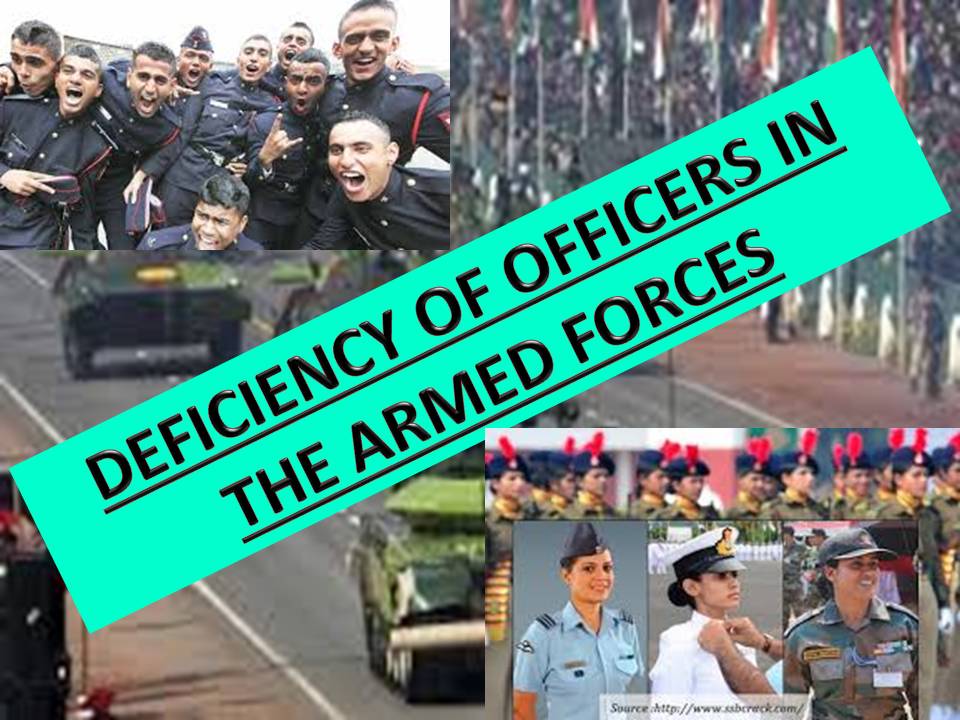
The Indian Armed Forces are the military forces of the Republic of India. It consists of three professional uniformed services: the Indian Army, Indian Navy, and Indian Air Force. Indian army is the third largest army in the world. India has a total of 1.4 million active army and 11.55 lakh reserve forces, as well as 20 lakh paramilitary forces. From outside, the holy cow status of the armed forces makes it difficult to question what is happening inside. For a period of over three decades now, the armed forces in India has been grappling with deficiency of personnel in both the Officer cadre as well as the jawans. The army is short of 7,298 officers from an authorized strength of 49,933, the Navy is short of 1606 officers against an authorized strength of 11352 officers and the IAF is short of 192 officers against an authorized strength of 12,584 Officers. This is despite the fact that there are women officers in all three services (1,560 women officers in the Army, 1,610 in IAF and 490 in Navy). The reasons, impact and possible solutions to the problems are being discussed as a part of this article.
Reasons For the Shortage
Despite the fact that lakhs of candidates appear for UPSC exam for the forces, however the deficiency still exists in the forces. If one analyses the demography of candidates appearing in Services Selection Board, it will be observed that there are miniscule / no candidates from the affluent / higher middle income strata of society or even from good schools. Largely candidates belong to lower income groups and are wards of Class III and IV employees. Out of these, more than 85% candidates are rejected in the first hour of interview(on psychological grounds) even BEFORE they enter the gates of the selection board. A large number of formal and informal studies have been conducted on the subject bringing out various reasons for the shortage. It may be observed, that some causes are noticed by the youth themselves and some are likely to be observed by youth due to the conditions of the serving/retired officers or families of martyrs/ disabled personnel.
1. Social Factors
(a) Risk Factor Armed forces is a high risk job. Today, when a young man has to choose between an office job with money and a combat job with lesser money, the former seems to win. People like to play it safe with their lives. Moreover, insurance cover for officers provided by Army Group Insurance Fund(AGIF) is only 50 Lakhs, which is meagre considering the futuristic requirements of a family.
(b) Pay and Allowances Disparity with Civilian Counterparts
Despite the risks involved, the salary in forces aren’t the best. The situation has worsened with sixth and seventh pay commission in comparison to other Class I Gazetted Officers, wherein except armed forces all other Class I Gazetted officers have been classified as Group A and granted Non Functional Upgradation(NFU). Non grant of NFU to armed forces as well as disparity in risk allowance has been demoralising. The admissibility of allowance to defence personnel in Leh is Rs 10,100 but for IPS/IAS officer of same level, it is Rs 54,810 in the same area.
- Disrupted Family Life With increased tenures on operational deployments and situations of unrest, an officer and his family are not able to enjoy family life. Education of children suffer due to postings or families are forced to live separately. This results in a deep sense of discontentment.
- Changing Morals and Ethics Increasing criminalisation of society, declining moral values, increasing materialisation and higher individual aspirations are also impacting the armed forces. The time tested military values of honesty, loyalty, integrity are under severe pressure. Cases of derogatory treatment to armed forces personnel by police and politicians is aggravating the problem
2. Organisational Factors
- Deputation in Rashtriya Rifles and Raising of New Units Over the past two decades force deployment in the newly raised Rashtriya Rifles has resulting in deficiency of officers in regular units.
- Lack of opportunities for Disabled Officers There is a total lack of opportunity for officers who have been disabled / incapacitated due to operational and exigencies of service. Besides the pension, Officers need to be fruitfully employed if they have to leave the forces early due to disability.
- Early Retirement The promotion pyramid in the army is too steep and if not promoted, the retirement age of officers in the Armed forces is as per the last rank held by the Officer. A Lieutenant Colonel / Colonel and equivalent retires at the young age of 54 years. It should also
be noted that there are approximately 9900 Lt Colonel/ Colonel retire at an age of 54 and are doomed to remain without employment for about 11 years of active life against the retirement age of 65 in corporate.
- Pre MatureRetirement Some officers seek pre mature retirement on being superseded. In maximum cases, such officers are in the functional bracket of Majors/ Lt Cols or equivalent and it reduces the functional strength of the forces.
- Lack of Motivation due to Supersession The promotion pyramid in the armed forces is not only too steep but also quite late as compared to civil counterparts.An officer is promoted to the rank of Lt Col or equivalent after 13 years of service, and a Major General at 26/28 years. A Lt Col / Col who gets superseded after being considered thrice for promotion has to continue serving in the same rank for next 20 years till he retires attaining age of superannuation of 54 years. This effects motivation, morale and efficiency of these officers whereas their counterparts in civil services continue to get promoted. The lack of motivation has been more pronounced due to denial of NFU (Non Functional Upgradation) to Officers of the Armed Forces ONLY.
(g) Short Service Officers not opting for Permanent Commission
The entry to Armed forces comprises of Permanent Commission through National Defence Academy and Indian Military Academy. Officers are also commissioned for Short Service comprising of seven years to fourteen years. As per a very senior Officer, “approximately 30-35% short service officers leave service after seven years due to better avenues available and also partially due to tough and hard working conditions in the Armed Forces”.
3. Political and Bureaucratic Factors
- Role of Politicians and Media . Political and media intervention has resulted not only in loss of face of the armed forces, but has also left the personnel thinking about the rationale for serving. In this regards, case of Maj Gogoi and Tihar jail sentence to the four jawans acting as per existing orders in Kashmir, are glaring examples.
- Apathy of Bureaucracy and Administration in Welfare Measures for Widows and NOK of Martyrs It is common knowledge that there is a complete apathy on part of civil administration and politicians towards welfare of families of martyrs and crippled soldiers. They have to run from pillar to post for the schemes announced for them. This has a negative impact on nears and dears.
- Status of Armed Forces vis a vis Civil Services Despite the fact that armed forces officers are Class I Gazetted Officers, they have a lower status vis a vis their civilian counterparts. This is due to policies favouring the civilian services. Cases in point is non grant of NFU to defence officers. A very glaring example is where a boss of the rank of Brig flies economy class and his civilian subordinate (of the same office) is flying executive class as he/ she is receiving a higher Grade Pay.
Impact of Shortage of Officers
The impact of shortage of officers is only felt at two levels – personal level by the officer and his family as well as at the unit level . However, both are interlinked and in a vicious cycle with one affecting the other.
- Personal Level At a personal level(including the family) the shortage of officers manifests in the following forms
- Stress Levels An officer today is always stressed physically and mentally as shortage of officers compel him to undertake multiple demanding tasks simultaneously with little time for relaxation. Even in peace stations, engagements coupled with zero error syndrome keep the stress levels maintained. These are also reflected in discord in family life of officers further increasing the stress levels.
- Curtailed Leave Under the present circumstances, 90-95% officers are neither granted full entitled leave at the time of their choice, nor are able to plan leave. In addition, more often than not, due to ad hoc requirements, they are recalled from leave. This adds to stress and frustration.
- Impact on Families As officers are not available to their families due to official commitments even during peace tenure, there is a sense of dissatisfaction amongst officers and families. These do lead to problems in the family.
- At Organisational Level In armed officers, the entitlement of officers is as per the role and requirement. There are no reserves available. Each officer has a definite set of tasks and is responsible for a defined group of men as well as equipment. Thus a deficiency of officers adversely effects the following at a unit level.
- Strength Available for Operational Duties Each officer has a dedicated role to play in operational duties. Shortage of officers adversely effect the operational efficiency and effectiveness of units as the task may have to be per force assigned to inexperienced / under trained officers. The problem is also aggravated due to medically downgraded officers in the armed forces.
- Training Standards of Officers and Men Armed Forces units are responsible to conduct training on equipment as well as operational procedures. Shortage of officers result in adversely effects the duration of training and the quality of training(as officers are involved in multiple tasks simultaneously).
- Maintenance of Equipment The supervision, checks, training the men in maintenance tasks, raising demands of spares and maintenance stores is the responsibility of the officer cadre. Shortage of officers will adversely affect the maintenance aspects and thus the operational readiness of costly equipment.
- Poor Administration Especially in the army, the officers are responsible for all administrative activities of men under their command which includes leave, promotion, courses, documentation, mental and physical health. Shortage of officers does necessarily affect the administration of the unit personnel, which further leads to dissatisfaction amongst the unit personnel and thus the morale of the unit.
- Mentoring of Young Officers Traditionally, the young officers were mentored and coached by the seniors in all aspects of military life from customs, traditions, operational procedures, administration etc. Shortage of officers has adversely effected this backbone of the armed forces.
- Professional and Technical Upgradation Modern warfare needs a mix of technical acumen and professional expertise to exploit the the armament to max advantage and effectiveness. For this purpose, officers are required to keep themselves abreast with technology. However, this aspect takes a back seat as officers are too busy with routine and mandatory tasks. This may lead to a definite disadvantage in the long term.
Possible Solutions
- The situation needs a holistic review at the level of Army HQ and MoD and a pragmatic outlook to improve the situation. However, the same would need a paradigm shift in the outlook of the politicians and bureaucracy for the same, as Third Pay Commission onwards (1972-73), a deliberate and systematic degradation of the Armed Forces has been effected by the govt and the bureaucracy.
11. Organisational Approach and Solutions
(g) Utilisation of Low Medical Category and Superseeded Officers While superseded officers necessarily are beyond an age of 43-44 years, but Low Medical Category Officers can be of any age. All such officers can be optimally utilised if placed on a job of their choice where they would work willingly. For rotation, these can be placed for the following vacancies:-
- Actual conduct of training at unit and level of Brigades.
- Projects being run and required to be manned by service officers
- Staff appointments at various headquarters
(b) Utilisation of Women Officers While women officers are theoretically sharing the duties of male officers, however, the handling of women officers by senior officers is with a silken glove. Therefore, women officers in units and field are assigned soft jobs which further puts stress on male officers as the soft jobs are plugged by women officers. (c) Interaction with Civil Servants A trend has set in where in civil servants tend to interact with the senior most officer in the area lowering the prestige of defence officers. It has to be a conscious effort on part of senior officers to direct the civil servants to interact with their counterparts only.
(d) Upgradation of Ranks for Low medical Category and Superseded Officers While the rank pyramid is steep and may be followed operationally, in order to keep the superseded officers motivated, a separate ranking structure can be designed, where in an officer continues to get promotions and yet be employed fruitfully.
- Political and Bureaucratic Approach This would involve change of mindset of the politicians and civil servants. Since Independence and particularly post 1971 war, there has been a deliberate degradation of the status of armed forces in terms of order of precedence, perks, pay and allowances. The outlook of politicians and bureaucrats need change in the following aspects:-
(a) Pay and Allowances of armed forces need to be equated with other Class I officers including grant of Non Functional Upgradation (NFU) akin to other Class I Gazetted officers. (b) It should be mandated for ministers, MPs, MLAs and bureaucrats of respective areas to attend funerals of martyrs of their areas.
- Decorated soldiers and gallantry award winners are not paid due respect by the politicians and civil servants , in contrast to the respect paid in western countries.
- Bureaucrats should be made to ensure personally the progress of receipt of benefits to families and NOK of martyrs, so that they do not have to run from pillar to post for the same.
- It will be in the interest of the nation and superseded / Low medical category officers, to give an opportunity to side step in police and administration to exploit their rich experience. This will also be in interest of the officers as well as the society. Easily, an officer retiring at 54 years of age can be utilised for at least 6-10 years for administration and in public interest.
- Establishing Shaheed Smarak and organising felicitations for decorated soldiers, disabled soldiers and families of martyrs at levels of state capitals will go a long way in giving recognition and maintaining the status of forces in the society.
Conclusion
- The shortage of officers in armed forces is just not a problem of numbers. It has operational, morale and social ramifications and are in a vicious cycle. However, number of various reasons contribute to the same. A holistic approach needs to be taken in order to resolve the same and a paradigm shift in the outlook is needed on part of the politicians, bureaucrats as well as the senior officers.
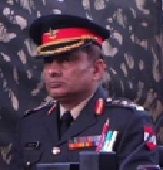
About the Author: Col Manoj Mehrotra is an alumni of the National Defence Academy and has now retired after 33 years of service. He was commissioned in the Army Air Defence and has a rich experience in different designations as well as locations. He has also been Principal Consultant to Department of Urban Development, Govt of MP for Smart City Projects. The views stated in the article are his personal .




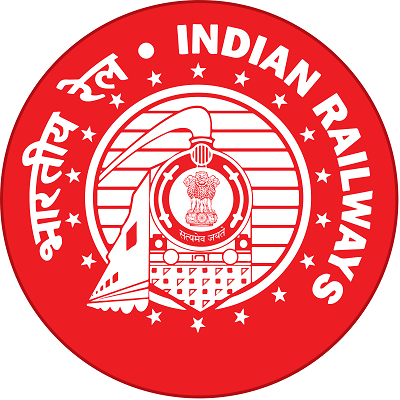
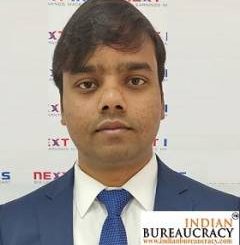
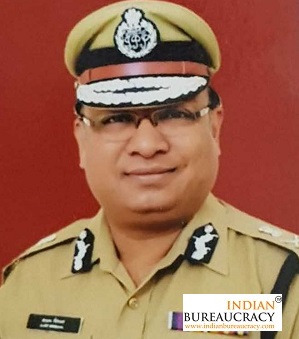
A very well composed and holistic article. Oriented towards the national well being.
Says so much in so less. And very well concluded.
Very well written. It should also be noted that hardly any wards of Officers are joining the forces.